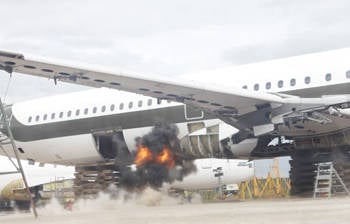Boffins' audacious plan to blow up aircraft foiled by bomb-proof bag
That is to say, their explosive experiments worked
Forsaken planes have been used in a series of boffinry experiments this week to test whether a bag lined with bomb-proof material could withstand an explosive blast.
A group of international scientists and academics from the University of Sheffield – backed by the European Commission and run by a consortium of businesses and organisations – carried out the tests in the luggage hold of a Boeing 747 and an Airbus 321 at Cotswolds Airport, near Cirencester.
They were able to successfully demonstrate such a blast being contained without causing damage to other areas of the aircraft by using the so-called Fly-Bag.
Such a heat-resistant, high strength bag could apparently help to keep passengers safe from certain types of explosive devices concealed within a bomber's luggage that could be detonated during a flight.
“Key to the concept is that the lining is flexible and this adds to its resilience when containing the explosive force and any fragments produced,” said the University of Sheffield's lead researcher, Andy Tyas, of the department of civil and structural engineering.

What a controlled bomb blast on an aircraft looks like sans a Fly-Bag.
Pic credit: University of Sheffield
“This helps to ensure that the Fly-Bag acts as a membrane rather than as a rigid-walled container which might shatter on impact.”
He added: “We have extensively tested Fly-Bag prototypes at the University of Sheffield’s blast-testing laboratory, but the purpose of these tests was to investigate how the concept works in the confines of a real aircraft and the results are extremely promising.”
At present, costly and heavy hardened luggage containers (HULD) are offered to airlines to attempt to mitigate bomb blasts on board an aircraft.
Unsurprisingly, the consortium behind the Fly-Bag – which was first developed in 2011 and can be adapted for use in cabin holds if the crew spots a potential threat – hopes to see a change in law to make it compulsory for airlines to use its technology. ®








 User Center
User Center My Training Class
My Training Class Feedback
Feedback











